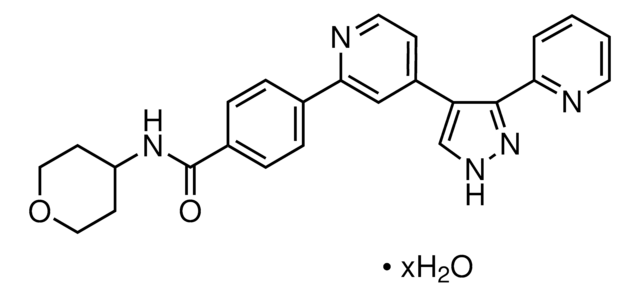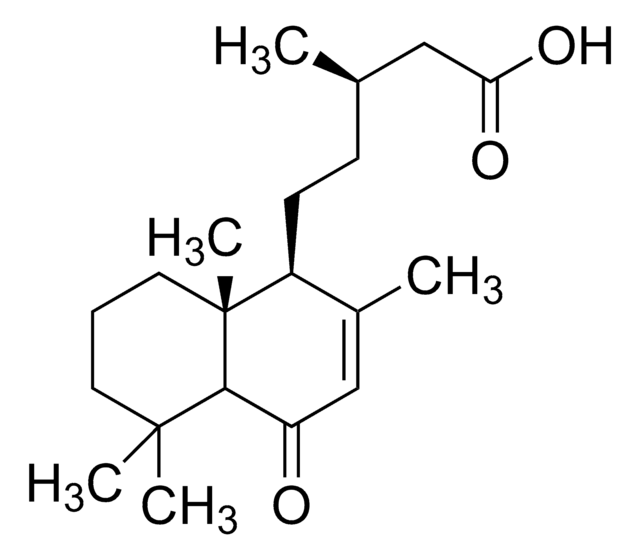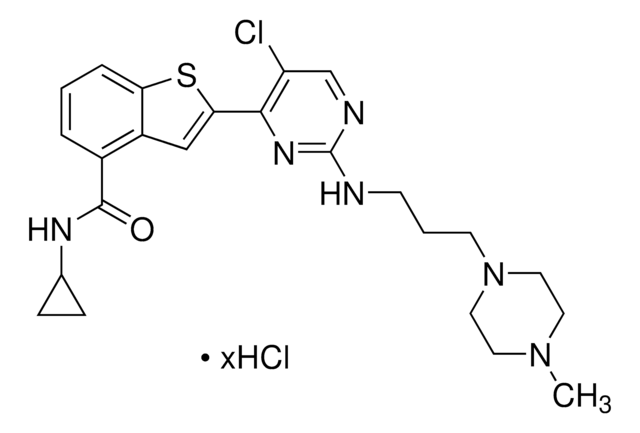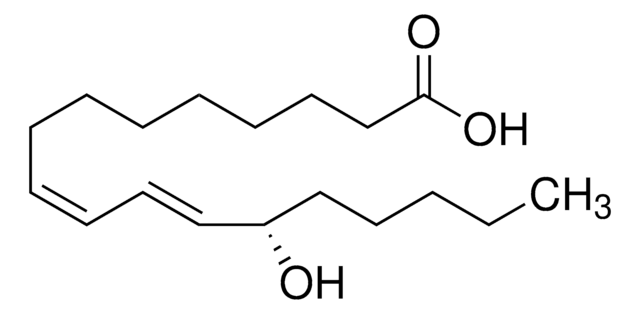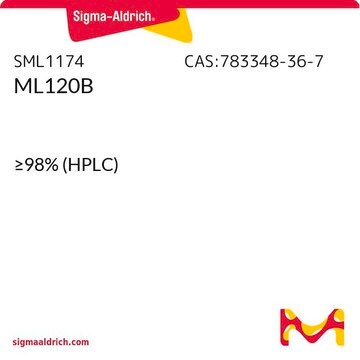H9146
13(S)-Hydroxyoctadeca-9Z,11E-dienoic acid
90-100 μg/mL in ethanol, ≥98%
Synonym(s):
13(S)-HODE
Sign Into View Organizational & Contract Pricing
All Photos(1)
About This Item
Empirical Formula (Hill Notation):
C18H32O3
CAS Number:
Molecular Weight:
296.44
EC Number:
MDL number:
UNSPSC Code:
12352200
PubChem Substance ID:
NACRES:
NA.77
Recommended Products
Quality Level
Assay
≥98%
concentration
90-100 μg/mL in ethanol
storage temp.
−20°C
SMILES string
CCCCC[C@H](O)\C=C\C=C/CCCCCCCC(O)=O
InChI
1S/C18H32O3/c1-2-3-11-14-17(19)15-12-9-7-5-4-6-8-10-13-16-18(20)21/h7,9,12,15,17,19H,2-6,8,10-11,13-14,16H2,1H3,(H,20,21)/b9-7-,15-12+/t17-/m0/s1
InChI key
HNICUWMFWZBIFP-IRQZEAMPSA-N
Biochem/physiol Actions
Expression of 15-lipoxygenase-1 (15-LOX-1) and its main product, 13(S)-HODE, are decreased in human colorectal and esophageal cancers. Certain non-steroidal anti-inflammatory drugs (NSAIDs) can induce apoptosis in human colon cancer cells by increased expression of 15-LOX-1, which down-regulates PPAR-delta through 13-HODE.
PPARγ agonist
Features and Benefits
This compound is featured on the Nuclear Receptors (PPARs) page of the Handbook of Receptor Classification and Signal Transduction. To browse other handbook pages, click here.
Packaging
Packaged under Argon.
Signal Word
Danger
Hazard Statements
Precautionary Statements
Hazard Classifications
Eye Irrit. 2 - Flam. Liq. 2
Storage Class Code
3 - Flammable liquids
WGK
WGK 1
Flash Point(F)
57.2 °F
Flash Point(C)
14 °C
Choose from one of the most recent versions:
Already Own This Product?
Find documentation for the products that you have recently purchased in the Document Library.
Claus Schneider et al.
Cancer metastasis reviews, 30(3-4), 277-294 (2011-10-18)
Cancer initiation and progression are multistep events that require cell proliferation, migration, extravasation to the blood or lymphatic vessels, arrest to the metastatic site, and ultimately secondary growth. Tumor cell functions at both primary or secondary sites are controlled by
Ming-Yue Li et al.
American journal of respiratory cell and molecular biology, 43(6), 674-683 (2010-01-19)
Peroxisome proliferator-activated receptor (PPAR)-α and PPARγ participate in cell proliferation and apoptosis. Few studies have simultaneously investigated both PPARα and PPARγ in lung cancers in vivo. The roles of PPARα and -γ were investigated in the development of pulmonary tumors
Shing Hwa Liu et al.
British journal of pharmacology, 160(8), 1963-1972 (2010-07-24)
Peroxisome proliferator-activated receptor-gamma (PPAR-gamma), COX-2 and 15-lipoxygenase (LOX)-1 have been shown to be involved in tumour growth. However, the roles of PPAR-gamma, COX-2 or 15-LOX-1 in gastric tumourigenesis remain unclear. Here, we investigate the role of 15-LOX-1 induction by honokiol
Ulaganathan Mabalirajan et al.
Journal of applied physiology (Bethesda, Md. : 1985), 107(4), 1285-1292 (2009-07-25)
We showed recently that IL-4 causes mitochondrial dysfunction in allergic asthma. IL-4 is also known to induce 12/15-lipoxygenase (12/15-LOX), a potent candidate molecule in asthma. Because vitamin E (Vit-E) reduces IL-4 and inhibits 12/15-LOX in vitro, here we tested the
Anna Z Pollack et al.
American journal of epidemiology, 175(7), 645-652 (2012-02-04)
Exposures to cadmium, lead, and mercury are associated with adverse health effects, including cardiovascular disease, which may be promoted by lipid peroxidation. The authors examined cadmium, lead, and mercury in relation to plasma levels of F(2)-8α isoprostanes (isoprostane), 9-hydroperoxy-10,12-octadecadienoic acid
Our team of scientists has experience in all areas of research including Life Science, Material Science, Chemical Synthesis, Chromatography, Analytical and many others.
Contact Technical Service